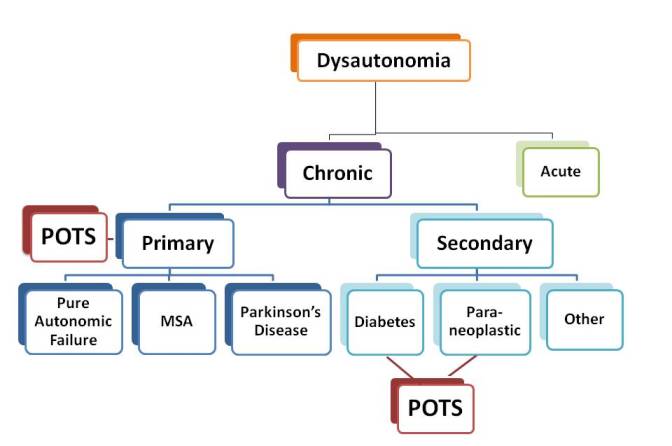Dysautonomia Conditions:
Primary and Secondary Conditions
"Dysautonomia" means the autonomic nervouse system is not working as it should. With Autonomic Nervous System Failure (ANF), the autonomic nervous system can't keep up with the physiologic demands. Physiologic demands means what the body needs to function. The ANS controls the automatic body functions - breathing, heart beating, blood pressure. With OI, the physiologic demands would mean what the body needs to control blood pressure and pulse when you stand up or exercise.
There are other medical conditions that people are more aware of that are due to autonomic nervous system failure. These other conditions are not as common but more people do know about them. Most of them have other autonomic symtoms besides the orthostatic symptoms with standing up.

Managing orthostatic symptoms with these conditions is very similar to managing OI with POTS and NMH with the younger person. There is more caution and need to work with your physician if you have diabetes, heart disease, elevated cholesterol, and other conditions that require medications. There can be more interaction with medication and fluid/salt balance needs special attention.
MSA stands for Multiple System Atrophy. It used to be called Shy Drager Syndrome. It includes Parkinsonism, Mixed and Cerebellar types.
Primary and Secondary Conditions
With the Dysautonomias, we have to step back and explain the difference between a primary condition and a secondary one.
Primary Condition: A primary condition is one that comes first - a cold is an example of a primary condition. You get infected with a virus and it causes a cold. If it gets really bad and you develop pneumonia, the pneumonia would be a secondary condition. It developed as a result of the first problem (the cold).
Secondary Condition: With dysautonomias, there are many primary conditions that can cause damage to the autonomic nervous system. An example of a primary conditions could be diabetes.
Where does POTS fit in this?
There seem to be a number of different ways to look at POTS. We have placed POTS on the side of the Primary section because there is one type that has autonomic symptoms and findings and is a "partial dysautonomia".
References
- Medow MS, Stewart JM, Sanyal S, Mumtaz A, Stca D and Frishman WH. Pathophysiology, Diagnosis, and Treatment of Orthostatic Hypotension and Vasovagal Syncope. Cardiology in Review 2008;16(1):4-20. Abstract
Author: Kay E. Jewell, MD
Page Last Updated: June 22, 2012
